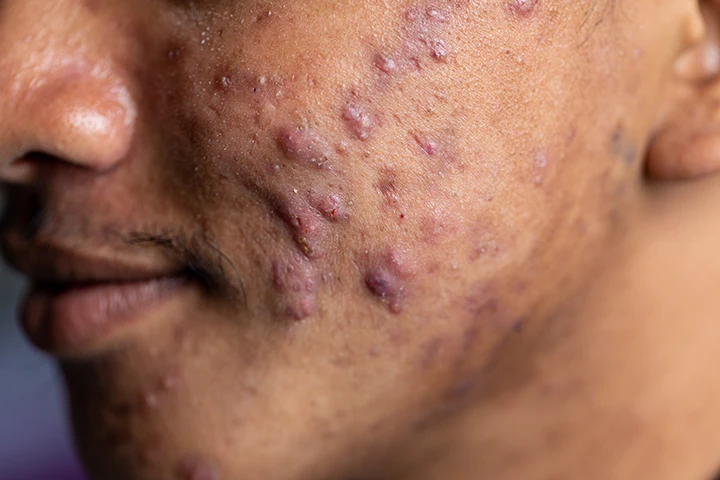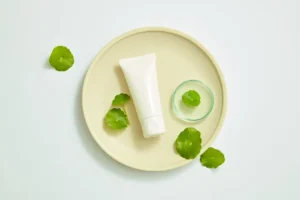Cystic acne isn’t your typical breakout. These inflamed bumps form beneath the skin’s surface, where they tend to stick around far longer than the average pimple. Unlike whiteheads or blackheads, cysts don’t always produce pus or rise to the surface – and when they do, it’s often after days of discomfort and swelling. What’s going on below the skin involves excess oil, trapped bacteria (Cutibacterium acnes), inflammation, and often, hormonal shifts.
This type of acne is notoriously persistent, but with the right approach, it can be managed. Let’s walk through what that looks like – starting with the foundation.
Get the Basics Right First
Before layering on treatments, the smartest first step is refining your routine. Skin prone to cystic acne is often reactive. Scrubs, strong acids, and “acne-fighting” everything may only make matters worse.
Here’s how to start:
-
Cleanser: Use a gentle, low-foaming cleanser that won’t strip your skin barrier.
-
Moisturizer: Yes, even oily skin needs it. A lightweight, non-comedogenic moisturizer keeps inflammation in check.
-
Sunscreen: Essential. Every single day. SPF 30 or higher helps prevent post-acne marks from darkening and slows down healing if you’ve already picked (don’t).
Keeping your routine simple gives your skin a chance to calm down. It also makes it easier to spot what’s working – or what’s not.
Don’t Let Impulse Take Over
We’ve all been there: you feel that painful bump coming on, and the first instinct is to try something – anything. But with cystic acne, restraint is key.
-
Don’t try to pop it. Cysts have no clear opening and applying pressure just increases swelling or pushes bacteria deeper.
-
Don’t dry it out with spot treatments like toothpaste or alcohol. They irritate your skin and do little for what’s underneath.
-
Don’t layer six products and hope one sticks. The more actives you throw on irritated skin, the more likely it is to revolt.
Cystic breakouts take time to resolve, and calm skin heals faster.
Targeted Ingredients That Actually Help
When it comes to ingredients, look for ones that address inflammation and prevent future blockages – not just surface bacteria.
-
Benzoyl Peroxide (2.5–5%): An antimicrobial that helps reduce bacteria and inflammation. Best used as a cleanser or spot treatment, ideally applied to dry skin after washing.
-
Topical Retinoids (like adapalene or tretinoin): These regulate skin turnover and prevent pore blockages. Apply at night, starting every other evening. Always use on dry skin and pair with moisturizer.
-
Sulfur or Azelaic Acid: If your skin leans sensitive, these are good alternatives. They help reduce redness and gently fight bacteria without the irritation common to stronger actives.
Introduce one new ingredient at a time and give it several weeks. That’s the timeline most clinical studies follow – and your skin needs that same patience.
When to Bring in a Dermatologist
If cystic acne is showing up often, leaving marks, or refusing to respond to OTC products, it’s time for medical support.
-
Oral antibiotics like doxycycline may be prescribed short-term to calm widespread inflammation.
-
Spironolactone, often used off-label for hormonal acne, helps reduce oil production in women by blocking androgen receptors.
-
Isotretinoin (Accutane) is reserved for severe or scarring acne that doesn’t respond to other treatments. It’s highly effective but comes with risks that require monitoring.
Dermatologists can also provide cortisone injections for individual cysts – a quick fix when you’re dealing with that one painful lump that won’t budge.
Treat Individual Cysts Gently
Not every cyst needs a new product. If you’re dealing with just one or two, smart, localized care can go a long way.
-
Warm compresses (not hot!) can help reduce swelling.
-
A sulfur-based cream or thin layer of benzoyl peroxide can help bring down inflammation if used early.
-
Avoid applying retinoids or acids directly to an irritated cyst – it won’t help and may worsen redness or peeling.
If it’s persistent or painful, ask your derm about a cortisone shot. It flattens the lesion within 1–2 days and can prevent scarring if caught early.
Lower the Chances of Future Breakouts
Cystic acne can’t always be “prevented,” but certain habits may reduce how often it shows up:
-
Keep track of your breakouts. Do they flare with your cycle? Stress? Certain foods?
-
Diet matters for some. High-glycemic foods – like white bread, sugar, and sodas – have been linked to increased acne severity in some studies.
-
Keep things clean. Change pillowcases often, wipe down your phone, and avoid touching your face throughout the day.
-
Go light on rich oils and heavy creams unless they’re specifically formulated for acne-prone skin.
You don’t have to overhaul your life – but small, consistent choices can help you stay ahead of the next breakout.
Cystic Acne FAQ
Do pimple patches work on cystic acne?
Regular hydrocolloid patches don’t reach deep enough to treat cystic lesions. However, microdart patches – infused with ingredients like salicylic acid or retinol – might help reduce swelling if used early in a breakout.
How long does cystic acne last?
A single cyst can stick around for 1 to 4 weeks. Deeper ones may take longer, especially if left untreated. Starting a proper treatment routine early helps minimize healing time.
What causes cystic acne to come back?
Hormonal fluctuations, chronic inflammation, dietary triggers, and inconsistent skincare routines are all common culprits. Underlying conditions like PCOS can also play a role.
Can diet cause cystic acne?
Possibly. Diet isn’t the root cause for everyone, but high-glycemic foods and dairy may worsen acne in some individuals. Consider tracking what you eat and how your skin responds over time.




